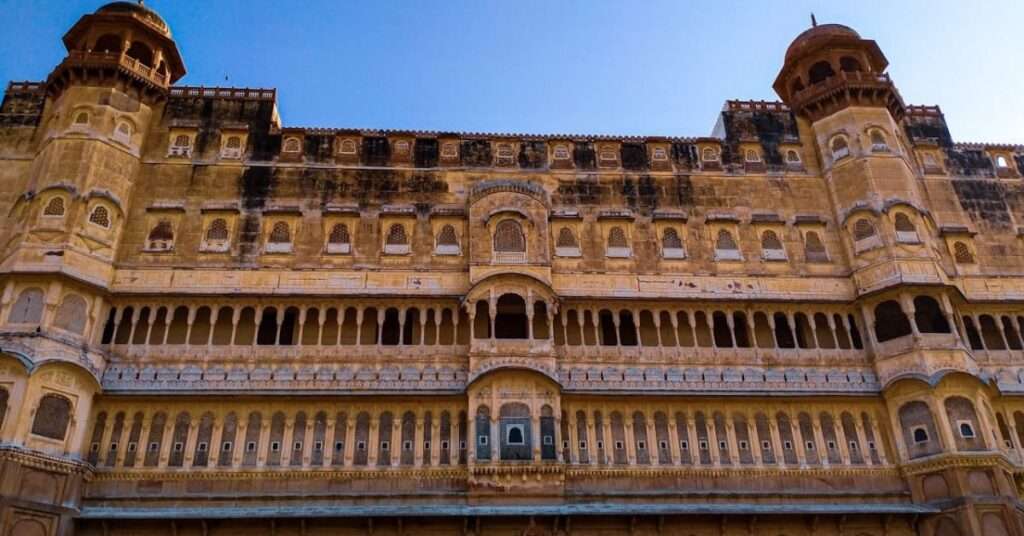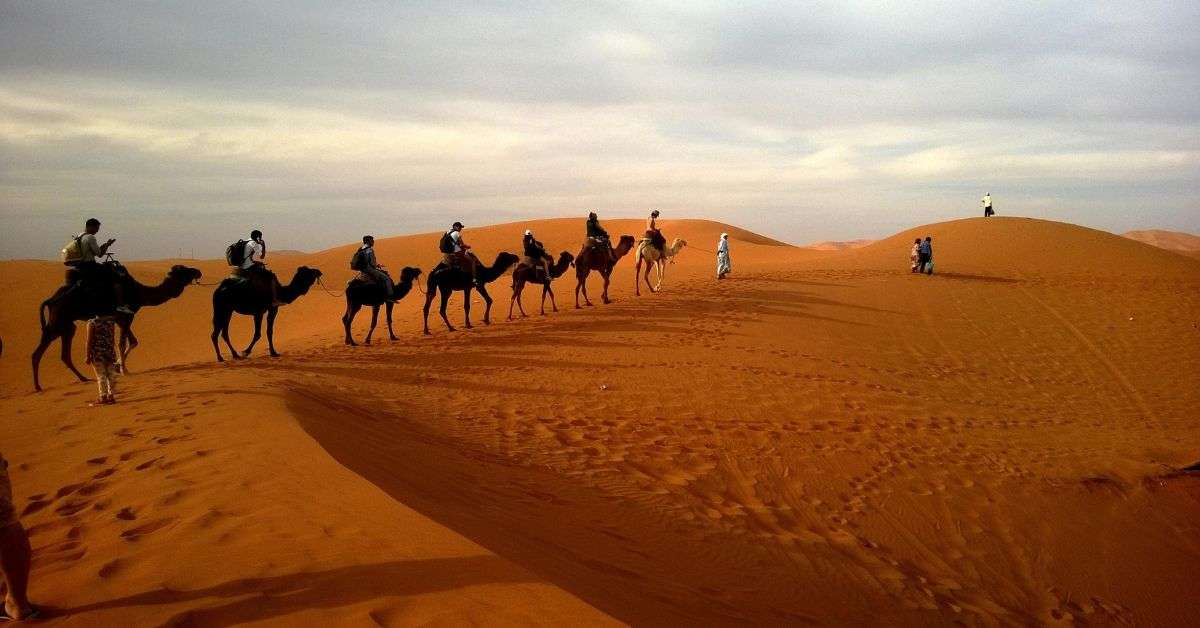The royal fortified city with a timeless appeal. Lying in the north of the desert state, the city is dotted with many sand dunes. Bikaner retains the medieval splendour that pervades the city’s lifestyle.
More popularly called the camel country, the city is renowned for the best riding camels in the world. The ship of the desert is an inseparable part of life here. Be it pulling heavy carts, transporting grains or working on wells, camels are the prime helpers.
The wells of Bikaner – an important source of water are other attractions of the city. These are built on high plinths with slender minareted towers on each of the four corners and can be noticed even from a distance.
Bikaner’s history dates back to 1488 A.D., when a Rathore Prince, Rao Bikaji a descendant of the founder of Jodhpur (1459 A.D.) Rao Jodhaji established his kingdom here. Rao Jodhaji had five sons but Rao Bikaji was the most enterprising of them. Bikaji chose a barren wilderness called Jangladesh’ and transformed it to an impressive city, called Bikaner after the founder’s name.
The strategic location of Bikaner on the ancient caravan routes that came from West/Central Asia, made it a prime trade centre in the times of the yore.
Bikaner stands on a slightly raised ground and is circumscribed by a seven km long embattled wall with five gates. The magnificent forts and palaces, created with delicacy in reddish-pink sandstone, bear testimony to its rich historical and architectural legacy. Undulating lanes, colourful bazaars and bright and cheerful folks make Bikaner an interesting experience.
Contents
- 1 PRIME SITES OF BIKANER
- 2 EXCURSIONS
- 3 FESTIVE FUN
- 4 BEST TIME TO VISIT BIKANER
- 5 ACCOMMODATION
- 6 TRAVEL INFORMATION
- 7 FAQ’s
- 7.1 Why is Bikaner called the “Citadel of Culture”?
- 7.2 Why is Bikaner associated with camels?
- 7.3 What is the Bikaner Camel Festival?
- 7.4 What makes Junagarh Fort unique?
- 7.5 What kind of food is famous in Bikaner?
- 7.6 How can I explore Bikaner’s camel heritage?
- 7.7 Are there any unique experiences in Bikaner?
- 7.8 What makes Bikaner different from other cities in Rajasthan?
PRIME SITES OF BIKANER
Junagarh:

Built in 1593 A.D. by Raja Rai Singh, a general in the army of Emperor Akbar, the fort is a formidable structure encircled by a moat and has some beautiful palaces within. These palaces, made in red sandstone and marble, make a picturesque ensemble of courtyards, balconies, kiosks and windows dotted all over the structure.
The Suraj Pol or Sun Gate:
It is the main entrance to the fort. Among the notable of these palaces are the exquisitely beautiful Chandra Mahal or the Moon Palace with marvellous paintings, mirrors and carved marble panels. and the Phool Mahal or Flower Palace ornate with glass and mirror work. Other palaces worth visiting are the Anup Mahal, Karan Mahal, Dungar Niwas, Ganga Niwas, Gaj Mandir and Rang Mahal. Gigantic columns, arches and graceful screens adorn the palaces from within. The Har Mandir is the majestic chapel for the royal family for worshipping their gods and goddesses.
Lal Garh Palace:
The architectural masterpiece in red sandstone, the palace was built by Maharaja Ganga Singh in the memory of his father Maharaja Lal Singh. The palace has beautiful latticework and filigree work. Sprawling lawns with blooming bougainvillea and dancing peacocks make it a not-to-be missed visual treat.
Part of the palace has been converted into a luxury hotel and a museum known as Shri Sadul Museum. The museum covers the entire first floor of the palace and houses well preserved old photographs and trophies of wildlife.
Ganga Golden Jubilee Museum :
It is the best Rajasthan museum, having one of the richest collections of terracotta ware, weapons, maniature paintings of Bikaner school and coins. The exhibits are splendid masterpieces of Harappan civilisation, Gupta and Kushan era and sculptures of the late classical time. The museum has a separate section displaying exclusive arts and crafts of the region.
Gardens and Parks:
Ganga Public Park with a Zoo, Ratan Bihari Temple Park and Tessitory Park are some of the lovely parks in the city. Surely worth a visit.
EXCURSIONS
Bhandasar Jain Temple (5 km):
Beautiful 16th century A.D. Jain temple dedicated to the 23rd Tirthankara, Parsavanathji.
Camel Research Farm (8 km):
Spend a day with the indispensable ship of the desert at their camel research and breeding centre – one of its kind in Asia. The farm extends over 2000 acres of semi arid land and is managed by the Central Government. The Camel Corps of Bikaner were a famous fighting force during the ‘Raj’ and are still an important part of the desert warfare and defence through the Border Security Force (BSF).
Devi Kund (8 km):
A royal crematorium with several ornamented cenotaphs or ‘chhatris’ built in the memory of the Bika dynasty rulers. Maharaja Suraj Singh’s chhatri is the most impressive of all, created entirely in white marble with spectacular Rajput paintings on the ceiling.
Gajner Wildlife Sanctuary (32 km):
The lush foliage of woods on the Jaisalmer road are a haven to nilgai, chinkara, black buck, wild boar and flocks of imperial sand grouse. The Gajner Palace, a summer retreat of the kings, stands on the bank of the lake and has been converted into a hotel.
Shiv Bari Temple (6 km):
Built by Doongar Singhji in the late 19th century. The temple in surrounded by an embattlement wall. It has beautiful paintings and a bronze Nandi facing the Shiva Lingam.
Deshnok’s Karni Mata Temple (30 km):
The famous 600 year old temple on the Jodhpur road dedicated to Karni Mata, an incarnation of Goddess Durga. The temple has huge intricately carved silver gates which were donated by Maharaja Ganga Singh.
The most interesting thing about the temple are the rats who scamper freely within the sanctum sanctorum of the temple. They are regarded as sacred and are fed by priests and devotees owing to the belief that they will be reincarnated as holy men.
Kolayatji (50 km):
A famous pilgrimage spot with a temple dedicated to Kapil Muni (saint). The temple is the venue for an annual fair held in the month of Kartik (Oct.-Nov.) when thousands of devotees gather in large number to take a sacred dip in the holy waters of the Kolayat lake on the full moon day. A cattle fair, especially for the trading of camels is a part of the festivities. The small oasis town is now an idyllic picnic spot.
Kalibangan (205 km):
The extensive remains of the pre-Harappan and Harappan civilizations, found at this place in the Hanumangarh district, are of immense interest to archaeology enthusiasts.
Visit Also – Ajmer: The Soul of Composite Cultures in Rajasthan 2025
FESTIVE FUN
The Camel Festival (January):
A spectacular event of camel performances, camel races, camel acrobatics, camel dances and camel milking competition are a part of the celebrations.
Kolayat Fair (November):
Coincides with Pushkar fair when pilgrims take a holy dip in the Kolayat lake on the full moon day in the month of Kartik. Gangaur Festival (April) : Dedicated to Goddess Parvati – the consort of Lord Shiva. Grand processions of the deity accompanied by dancing women are a part of the eighteen day long celebrations.
Holi: (March):
Exuberant festivities begining several days before the actual day of Holi, make it a special and spectacular occasion.
BEST TIME TO VISIT BIKANER
Winter (October to March): This is the ideal time to visit Bikaner. The weather is pleasant, making it perfect for sightseeing and outdoor activities.
Avoid Summer (April to June): The summer months are scorching hot, making it uncomfortable to explore the city.
Visit Also – Discover Barmer: A Hub of Traditional Art and Crafts in Rajasthan 2025
ACCOMMODATION
Heritage Hotels:
- The Laxmi Niwas Palace: Immerse yourself in the grandeur of the past at this magnificent palace hotel. Its opulent interiors, sprawling gardens, and royal ambiance create an unforgettable experience.
- The Lallgarh Palace: Another architectural marvel, this heritage hotel boasts stunning frescoes, intricate carvings, and a regal atmosphere.
- Hotel Raj Vilas Palace: Experience the charm of a bygone era at this palace hotel, offering luxurious rooms, a beautiful courtyard, and a glimpse into the rich history of Bikaner.
Budget Hotels:
- Hotel Bhanwar Niwas (Rampuria Haveli): This charming haveli offers comfortable rooms at affordable prices, providing a taste of traditional Rajasthani hospitality.
- HOTEL ROYAL INN: A budget-friendly option with clean and comfortable rooms, ideal for travelers on a shoestring budget.
- HOTEL BIKALAL: Another affordable choice, providing basic amenities and a convenient location.
Other Notable Options:
- Hotel Bharat Palace: A mid-range hotel offering a blend of comfort and affordability.
- Hotel lalji: A popular choice for budget travelers, known for its cleanliness and friendly service.
- Hotel Harasar Haveli: Another budget-friendly option with a traditional Rajasthani feel.
TRAVEL INFORMATION
HOW TO GET THERE:
- By Air: The nearest airport is Jodhpur International Airport, which is well-connected to major cities in India. From Jodhpur, you can hire a taxi or take a bus to Bikaner.
- By Train: Bikaner has its own railway station, well-connected to major cities like Delhi, Jaipur, and Jodhpur.
- By Road: Bikaner is connected by road to major cities in Rajasthan. You can hire a taxi or take a bus to reach Bikaner.
Getting Around Bikaner:
- Rickshaws: A popular and affordable mode of transportation.
- Auto-rickshaws: A convenient way to explore the city.
- Car Rentals: A good option for those who prefer self-drive tours.
FAQ’s
Why is Bikaner called the “Citadel of Culture”?
Bikaner is known as the “Citadel of Culture” due to its rich heritage, including majestic forts, intricate palaces, and vibrant traditions. The city’s cultural tapestry is evident in its festivals, cuisine, and artistic legacy.
Why is Bikaner associated with camels?
Bikaner is often referred to as the “Camel Capital of India” because of its long-standing camel trade and breeding practices. It is home to the National Research Centre on Camels and hosts the annual Camel Festival, celebrating the animal’s importance in desert life.
What is the Bikaner Camel Festival?
The Bikaner Camel Festival is an annual event held in January that showcases camel races, camel dances, and cultural performances. It celebrates the camel’s role in Rajasthan’s culture and economy.
What makes Junagarh Fort unique?
Unlike many forts in Rajasthan built on hills, Junagarh Fort is constructed on flat terrain. It is renowned for its well-preserved interiors, intricate frescoes, and a blend of Rajput and Mughal architecture.
What kind of food is famous in Bikaner?
Bikaner is famous for:
Bikaneri Bhujia: A spicy snack loved worldwide.
Dal Baati Churma: A traditional Rajasthani dish.
Kesar Kulfi: A saffron-flavored frozen dessert.
How can I explore Bikaner’s camel heritage?
To experience Bikaner’s camel heritage, visit the National Research Centre on Camels, participate in camel rides, and attend the Camel Festival. You can also explore desert camps offering camel safaris.
Are there any unique experiences in Bikaner?
Yes, unique experiences include:
Tasting camel milk and camel-milk products at the Camel Research Centre.
Attending the Karni Mata Temple in Deshnoke.
Staying in desert camps for an authentic Thar Desert experience.
What makes Bikaner different from other cities in Rajasthan?
While other Rajasthani cities are known for lakes or mountains, Bikaner stands out for its unique desert charm, strong camel heritage, and quirky attractions like the Rat Temple.
